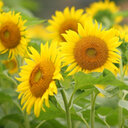Cytotoxic and potential anticancer constituents from the stems of Schisandra pubescens.
Atslēgvārdi
Abstrakts
BACKGROUND
The diethyl ether extract of the stems of Schisandra pubescens Hemsl. et Wils. (Schisandraceae) was found to exhibit cytotoxic activity in vitro. However, investigations of the bioactive constituents of this plant have been very limited.
OBJECTIVE
Elucidation of the cytotoxic constituents of S. pubescens was performed.
METHODS
Repeated silica gel column chromatography and preparative TLC were used for the chemical investigation of the diethyl ether extract of S. pubescens stems. All isolates were evaluated for their in vitro cytotoxicity against A549, PC-3, KB and KBvin human cancer cell lines.
RESULTS
Nine known compounds were obtained, including four lignans, epischisandrone (1), tigloylgomisin P (2), cagayanone (3) and (-)-gomisin L₂ (4), together with five triterpenoids, micranoic acid B (5), lancifodilactone H (6), coccinic acid (7), schisanlactone B (8) and anwuweizonic acid (9). Compounds 2-6 and 8 showed moderate to marginal cytotoxicity, with GI₅₀ values of 11.83-35.65 μM.
CONCLUSIONS
The isolation of 1-9 from S. pubescens and the cytotoxicities of 3-6 are first reported. Compounds 2-6 and 8 could be the active principles responsible for the anticancer effects of S. pubescens.


